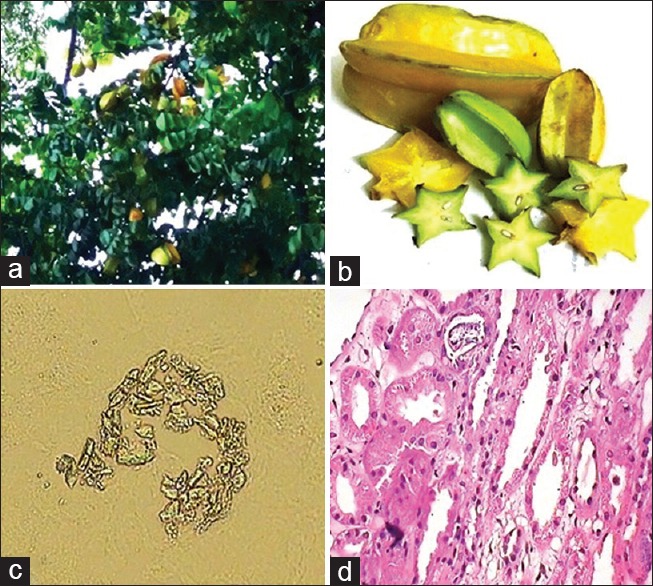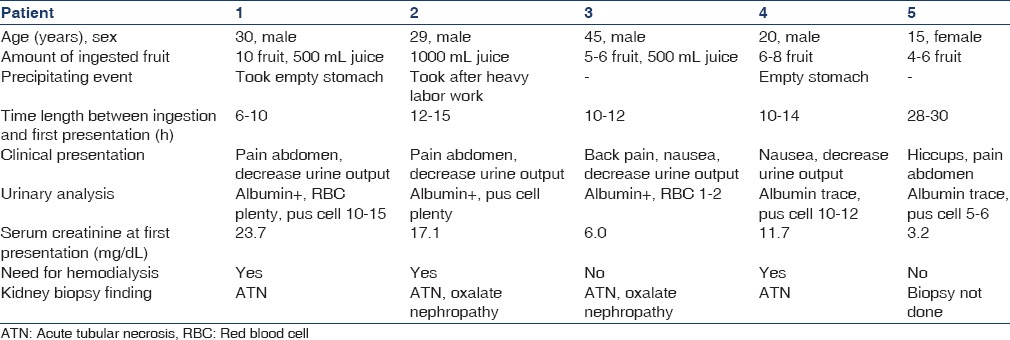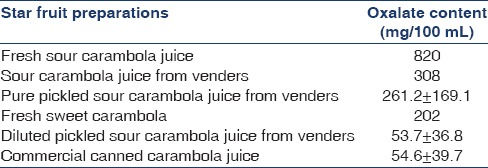Abstract
Starfruit (Averrhoa carambola) and its juice are popular in the Indian subcontinent as an indigenous medicine. Oxalate concentration in this fruit and it's freshly prepared juice is very high. We present a report of patients presenting with acute kidney injury due to oxalate nephropathy admitted in a single center. All patients had history of ingesting star fruit. Patients became symptomatic after 10–12 h of eating and main symptoms were pain abdomen and decrease in urine output. Three patients needed hemodialysis. All improved with complete renal recovery. Taking star fruit in large amount on an empty stomach and in a dehydrated state is a risk factor for nephrotoxicity.
Keywords: Acute kidney injury, oxalate nephropathy, star fruit
Introduction
Star fruit (Averrhoa carambola) [Figure 1a and b], a member of Oxalidaceae family, is popular in many tropical and subtropical countries, and its consumption is high in Asia, Central America, and tropical west Africa.[1] In India, it is recognized as kamrakh in Hindi and kordoi in Assamese. The plant grows primarily in the Northeast, the Southern States and along the coast, extending from Kerala up to West Bengal. It is a star shaped fruit with sweet and sour flavor. Traditionally use for treating diabetes, fever and sooth eye infections, throat infections, cough, asthma, colic, diarrhea, food poisoning, and mouth ulcer.
Figure 1.

Star fruit or Averrhoa carambola (a and b). Microscopic views of biopsy specimens (c: Frozen section, ×40). Dilation of renal tubules, interstitial edema, and an interstitial deposition of oxalate crystals (d: H and E, ×40)
Star fruit toxicity in patients with renal failure is well known.[2,3,4] These patients mainly presented as neurological involvement as hiccups, vomiting, mental confusion, seizures, coma, and even death.[2,4] Individuals with normal renal function, who ingest star fruit in a large amount, main symptoms are intractable and persistent hiccups. Nephrotoxicity in these people is a rare event, and only few case reports publish worldwide.[5,6] In this report, we present five patients with normal renal function who developed nephrotoxicity after eating star fruit or drinking star fruit juice.
Case Report
All cases in our report had a history of ingesting star fruit and clinically presented as acute kidney injury (AKI). Baseline characteristics, the amount of star fruit ingested, clinical presentation and relevant investigation of all patients are summarized in Table 1. Case 1 and 3 ingested star fruit both as fruit and juice simultaneously. Two patients (Case 1 and 4) consumed fruit on an empty stomach and one patient (Case 2) after heavy work in hot weather. Patients became symptomatic after 10–12 h (except Case 5) of eating star fruit. The main clinical presentation was pain abdomen and decrease in urine output. The severity of renal failure was maximum in Case 1 (serum creatinine – 23.7 mg/dl) who ingested highest amount of star fruit [Table 1]. Three patients needed hemodialysis. All patients recovered completely after treatment.
Table 1.
Clinical features and relevant investigations of patients

Renal biopsy was done in four patients. Biopsy finding suggested typical feature of acute tubular necrosis. Light microscopy suggested unremarkable glomeruli with mild mesangial expansion. Proximal tubules show extensive loss of epithelial brush border with cytoplasmic vacuolization in cells. There was severe interstitial edema along with inflammatory cell infiltration mainly mononuclear cell. In two patients (Case 2 and 3), few irregular crystals were seen in the interstitium and within the tubular lumen [Figure 1c and d]. They were mostly colorless and birefringent on polarized light, suggesting oxalate crystal. There was no evidence of thrombus, fibrinoid necrosis, or emboli within vessels.
Discussion
India is one of the largest producers of star fruit. Peak season of cultivation is September/October or January/February. Ripe fruits are golden yellow and sweet in taste while unripe fruits are lime green and taste sour, due to its high oxalate content as compared to sweet one.[5]
To the best of our knowledge, there is no report published yet about star fruit induced renal failure from the Indian subcontinent. Though case reports are available on AKI due to other fruits as Irumban puli (Averrhoa bilimbi) which belongs to the same Oxalidaceae family as star fruit with high oxalate content.[7] Star fruit is a rich source of oxalate. According to Chen et al.,[5] oxalate content of various preparations of star fruit is different [Table 2]. Ingesting star fruit in large amount can cause secondary oxalosis that presents as nephrocalcinosis, urolithiasis, and renal insufficiency.
Table 2.
Oxalate content of star fruit from different preparations

All patients ingested the fruit or its juice or both. The presentation was gastrointestinal (GI) upset within hours after ingestion followed by AKI, represented as decreased unit output in an otherwise healthy adult. GI symptoms were not due to uremia as uremic symptom cannot develop soon after ingestion and suggest direct corrosive injury of oxalate in the digestive tract.[8] Patients mostly reported 10–12 h after taking star fruit. This duration was less in previous case reports.[5,6] The reason may be due to the difference in initial clinical presentation. In the present case report, patients mainly presented with GI and renal involvement as compared to previous case reports where the neurological symptom was more common as first clinical presentation. All patients had a good outcome with complete recovery of their renal function though a long-term follow-up needed to rule out the risk of development of chronic kidney disease in future.
Various experimental studies show that plant containing high oxalate content may cause nephrotoxicity in animals like rat.[9,10] According to these studies, large content of oxalate in star fruit can cause acute oxalate nephropathy. The mechanism by which tubular damage occurred is the obstruction of renal tubules by these crystals. However, it was observed that tubular dilatation was much more extensive than the crystal deposition, especially in human cases[5] and the focal tubular deposition of crystals were not compatible with the profound loss of glomerular filtration rates. Studies found that in addition to the obstructive effect of the crystals, the oxalate alone could act as a cellular toxin capable of producing acute cell damage by increasing apoptotic effect on the renal epithelial cell.[11,12] Oxalate crystals were found in two biopsies, but severe AKI changes were present in all patients.
Those patients who ingest star fruit in a large amount, presents as severe AKI, though we still do not know the maximum recommended safe amount of star fruit or juice. Consuming large amount of star fruit (either fruit or juice), or even smaller amount on an empty stomach or in a dehydrated state; should be recognized as a risk factor for star fruit toxicity.[5,6]
Conclusion
In country like India where star fruit consumed routinely, physician should educate peoples even with normal renal function, not to ingest star fruit in large amount, especially empty stomach or in dehydrated state to avoid oxalate nephropathy.
Financial support and sponsorship
Nil.
Conflicts of interest
There are no conflicts of interest.
References
- 1.Morton JF. Fruits of Warm Climates. Miami, FL: Flair Books; 1987. pp. 125–8. [Google Scholar]
- 2.Neto MM, Robl F, Netto JC. Intoxication by star fruit (Averrhoa carambola) in six dialysis patients? (Preliminary report) Nephrol Dial Transplant. 1998;13:570–2. doi: 10.1093/ndt/13.3.570. [DOI] [PubMed] [Google Scholar]
- 3.Chang JM, Hwang SJ, Kuo HT, Tsai JC, Guh JY, Chen HC, et al. Fatal outcome after ingestion of star fruit (Averrhoa carambola) in uremic patients. Am J Kidney Dis. 2000;35:189–93. doi: 10.1016/s0272-6386(00)70325-8. [DOI] [PubMed] [Google Scholar]
- 4.Neto MM, da Costa JA, Garcia-Cairasco N, Netto JC, Nakagawa B, Dantas M. Intoxication by star fruit (Averrhoa carambola) in 32 uraemic patients: Treatment and outcome. Nephrol Dial Transplant. 2003;18:120–5. doi: 10.1093/ndt/18.1.120. [DOI] [PubMed] [Google Scholar]
- 5.Chen CL, Fang HC, Chou KJ, Wang JS, Chung HM. Acute oxalate nephropathy after ingestion of star fruit. Am J Kidney Dis. 2001;37:418–22. doi: 10.1053/ajkd.2001.21333. [DOI] [PubMed] [Google Scholar]
- 6.Neto MM, Silva GE, Costa RS, Vieira Neto OM, Garcia-Cairasco N, Lopes NP, et al. Star fruit: Simultaneous neurotoxic and nephrotoxic effects in people with previously normal renal function. NDT Plus. 2009;2:485–8. doi: 10.1093/ndtplus/sfp108. [DOI] [PMC free article] [PubMed] [Google Scholar]
- 7.Bakul G, Unni VN, Seethaleksmy NV, Mathew A, Rajesh R, Kurien G, et al. Acute oxalate nephropathy due to ‘Averrhoa bilimbi’ fruit juice ingestion. Indian J Nephrol. 2013;23:297–300. doi: 10.4103/0971-4065.114481. [DOI] [PMC free article] [PubMed] [Google Scholar]
- 8.Konta T, Yamaoka M, Tanida H, Matsunaga T, Tomoike H. Acute renal failure due to oxalate ingestion. Intern Med. 1998;37:762–5. doi: 10.2169/internalmedicine.37.762. [DOI] [PubMed] [Google Scholar]
- 9.Fang HC, Chen CL, Wang JS, Chou KJ, Chiou YS, Lee PT, et al. Acute oxalate nephropathy induced by star fruit in rats. Am J Kidney Dis. 2001;38:876–80. doi: 10.1053/ajkd.2001.27710. [DOI] [PubMed] [Google Scholar]
- 10.Fang HC, Lee PT, Lu PJ, Chen CL, Chang TY, Hsu CY, et al. Mechanisms of star fruit-induced acute renal failure. Food Chem Toxicol. 2008;46:1744–52. doi: 10.1016/j.fct.2008.01.016. [DOI] [PubMed] [Google Scholar]
- 11.Jonassen JA, Cao LC, Honeyman T, Scheid CR. Mechanisms mediating oxalate-induced alterations in renal cell functions. Crit Rev Eukaryot Gene Expr. 2003;13:55–72. doi: 10.1615/critreveukaryotgeneexpr.v13.i1.50. [DOI] [PubMed] [Google Scholar]
- 12.Sarica K, Yagci F, Bakir K, Erbagci A, Erturhan S, Uçak R. Renal tubular injury induced by hyperoxaluria: Evaluation of apoptotic changes. Urol Res. 2001;29:34–7. doi: 10.1007/s002400000150. [DOI] [PubMed] [Google Scholar]


